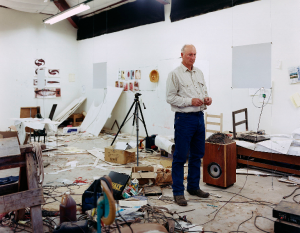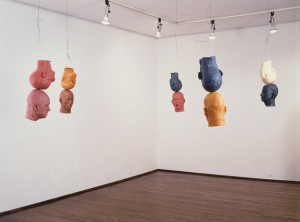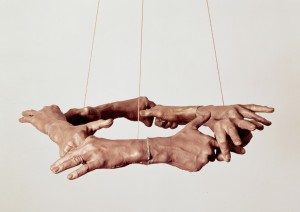
Bruce Nauman
Artist Bio
For several decades, Bruce Nauman has led a generation of artists less interested in aesthetic concerns than in how art carries meaning. Specifically, he expanded the discipline’s capacity for bringing a multisensory experience to the viewer, drawing them out of their areas of comfort into often protean places where meaning is lost and gained at a furious pace. Nauman cites the expressive gesture of Willem de Kooning and the coded reflection on signs and symbols of Jasper Johns as direct precedents, but a host of other influences gives Nauman’s art its unusual intensity and edge, namely philosophy, theater, performance, video, and dance. The resulting work is a human drama involving confrontations between a viewer and the limitations of thought, emotion, and communication.
Ten Heads Circle/Up and Down, 1990, is a series of wax-cast heads, separated into groups of two. In the work, Nauman sets up an imaginary conversation, or philosopher’s circle, and in reference to Johns, he uses wax fragments of bodies to form this circuit of communication. However, Nauman’s intercourse has a rough, makeshift quality and it is difficult to envision the heads in any sort of coherent connection; they hang from the ceiling on clumsy wire, some right side up and others upside down, they seem incapable of looking each other in the eye, and they have wax pouring from their mouths. As the viewer wanders through this circle, the impression is that the human capacity for communication has been somehow frustrated or thwarted.
Untitled (Hand Circle), 1996, has a similar but ultimately different approach. While Ten Heads Circle/Up and Down may be considered an expression of the failure of communication, Untitled (Hand Circle) is closer to the rudiments of how this failure is possible, of how meaning itself works. In the piece, Nauman creates a ring of severed right and left hands, joined at the wrist, in a circle. The connection point of one pair of hands to the next forms a symbol that is as instantly recognizable as it is ambiguous—the insertion of a pointer finger into a hand. This gesture could be a reference to sex, to the physical action of popping one’s joints, to bodily functions, or to other meanings. The ultimate nature of Nauman’s symbol remains circular and evolving, preventing any one reading over another. Furthermore, the fact that the piece is made of bronze is another critical element—the critique of the fixed and transcendent meaning claimed for sculpture throughout history is now traded in for a new, more contingent understanding.

